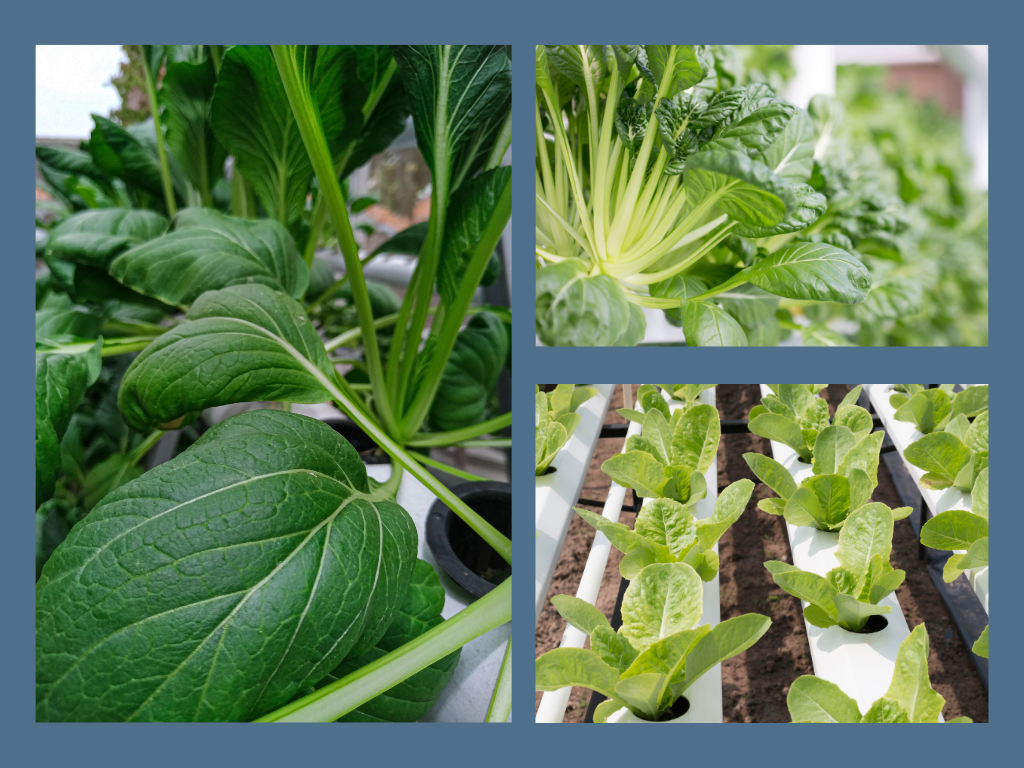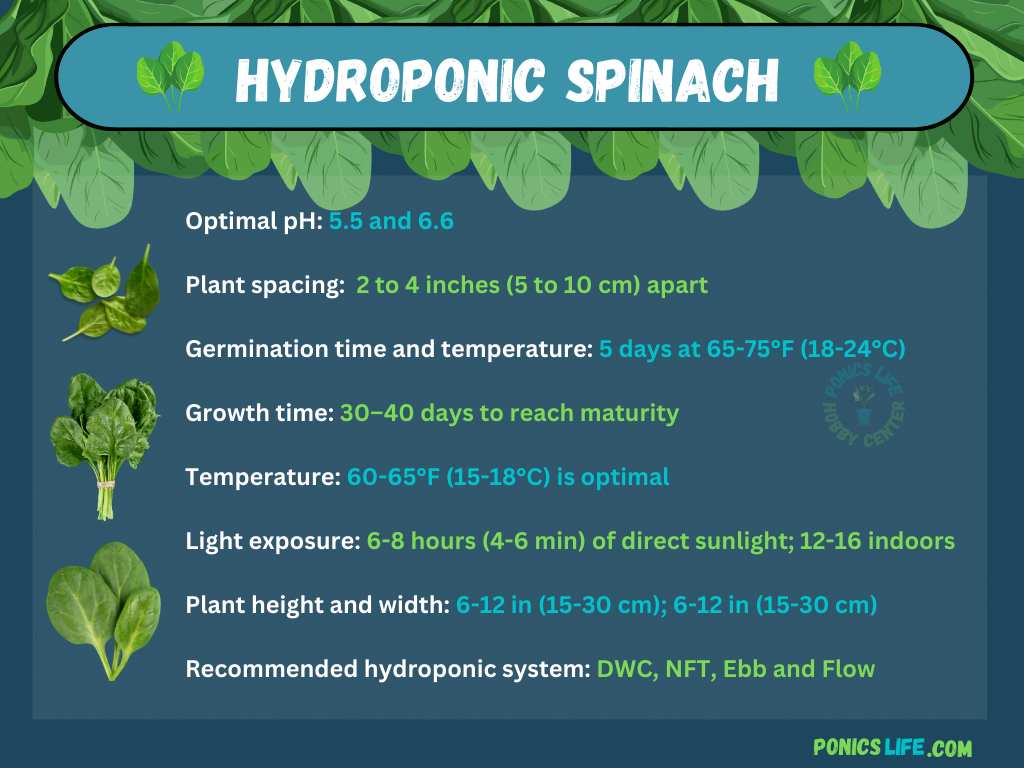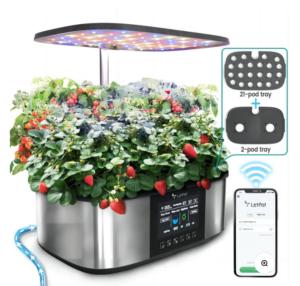Hydroponic Spinach
Embark on the rewarding journey of hydroponic spinach cultivation with our comprehensive guide. This resource is tailored to assist both novices and seasoned gardeners in navigating the intricate yet accessible world of hydroponics, ensuring a lush, thriving spinach crop. From understanding different hydroponic systems to mastering harvesting techniques, our guide is your go-to for all things spinach in hydroponics.
Table of Contents:
- Hydroponics Systems for Spinach
- Growing Conditions for Hydroponic Spinach
- Starting Spinach Seeds
- How to Grow Spinach Hydroponically
- How to Harvest and Store Spinach
- Frequently Asked Questions (FAQs)
Spinach in Hydroponic Systems
There are six basic types of hydroponic systems, Wick, DWC, Ebb and Flow, NFT, Drip, and Aeroponics, each offering unique advantages for cultivating plants. Spinach, in particular, will thrive in any one of them, making it a versatile choice for hydroponics.

Wick Systems
Wick systems are simple and suited for beginners. They use wicks to absorb and transport nutrients to the plants, offering a steady, low-maintenance option for growing spinach.
Deep Water Culture (DWC)
Deep Water Culture (DWC) submerges spinach roots in a nutrient-rich water solution, promoting faster growth. It’s effective but will require consistent monitoring of water quality and oxygen to maintain healthy roots.
Ebb and Flow (Flood and Drain)
The Ebb and Flow (Flood and Drain) system floods the growing area with nutrients and then drains it, providing cycles of nutrient uptake and oxygenation to the roots. Due to the balance of wet and dry conditions, it’s a great system for spinach.
Nutrient Film Technique (NFT)
NFT provides a constant flow of nutrient solution over the roots, which is ideal for the relatively quick-growing spinach. It will require some attention to ensure the film of nutrients remains uninterrupted.
Drip System
Drip systems deliver nutrients directly to the base of each plant, allowing for precise control over nutrient uptake (Dutch Bucket systems are a good example). While this will certainly work for spinach, drip systems are better for larger plants, where it’s more important to separate plants based off root size/nutrient requirements.
Aeroponics
In aeroponic systems, roots hang in the air and are misted with nutrients. This maximizes oxygen exposure and nutrient absorption. It’s a more advanced method that can lead to faster growth rates and will work with spinach.
The Kratky Method (Honorable Mention)
The Kratky method is a passive approach where plants grow in a partially filled nutrient solution that lowers as the plant consumes it, allowing for air root growth. It’s straightforward and doesn’t require electricity, but you’ll have less control over the nutrient levels.
Growing Conditions for Hydroponic Spinach
Spinach, when grown hydroponically, requires specific conditions to thrive. For the best results, it’s essential to carefully manage various factors such as pH levels, seed depth and spacing, germination time and optimal temperature, time to maturity, lighting needs, and preferred reservoir temperature.

pH
The optimal pH for spinach is between 5.5 and 6.6. It’s known to be somewhat tolerant of variations outside this range, but for optimal growth and health, try to maintain the pH within these limits.
EC
Spinach prefers an EC range between 1.8 and 2.3, which ensures the right balance of nutrients in the water. Maintaining this EC level is crucial for optimal growth and nutrient uptake, helping to produce healthy, vibrant leaves.
Seed Depth and Spacing
Spinach seeds should be planted at a depth of about 0.5 inches (1.27 cm) and spaced approximately 2 to 4 inches (5 cm to 10 cm) apart. If you’re starting indoors with plans to transplant, a few inches between each seedling should suffice.
Germination Time and Germination Temperature
In temperatures of 65-75°F (18-24°C), spinach typically germinates in about 5 days. If the temperature is between 59°F (15°C) and 86°F (30°C), expect germination to take around 5 to 7 days. Germination rates drastically slow below 41°F (5°C) and are unlikely at all at 95°F (35°C) and above.
Time to Maturity
Spinach generally takes 30 to 40 days to reach maturity. However, in optimal hydroponic conditions with perfect lighting, nutrients, and temperature control, it may mature more quickly.
Light Required
Spinach prefers 6 to 8 hours of direct sunlight a day, but needs a minimum of 4 to 6 hours a day. While spinach will tolerate partial shade/partial sun, it will do better with full sun in the Spring and Fall months. If growing under grow lights (indoors), ensure that spinach receives between 12 and 16 hours of light to mimic natural conditions.
Growing Temperature (Air)
Spinach, a robust and quick-growing cool-season crop, does best between 40-75°F (4-24°C), with the fastest growth at 60-65°F (15-18°C). It can withstand 15° to 20°F (-9° to -6°C) without damage, but freezing may harm tiny seedlings and mature plants. Intermediate-sized plants can endure below-freezing temperatures for extended periods.
Preferred Reservoir Temperature
If you’re able to manipulate the water/reservoir temperature, try to keep the nutrient reservoir slightly cooler than the ambient temperature, ideally between 60-65°F (15.6°C to 18.3°C), to promote healthy root development. While most vegetables thrive when their root zone temperature is between 68-72 °F (20°C to 22.2°C), spinach does well when it’s a little bit cooler.
Recommended Hydroponic System
While spinach can adapt to most systems, it performs particularly well in DWC, Ebb and Flow, and NFT setups. Systems like Wick, Drip, and Aeroponics can also be effective but may require more precise management.
USDA Plant Hardiness Zone
Hardiness zones for spinach include 2a, 2b, 3a, 3b, 4a, 4b, 5a, 5b, 6a, 6b, 7a, 7b, 8a, 8b, 9a, 9b, 10a, 10b, 11a, 11b.
Starting Spinach Seeds
Starting spinach seeds for hydroponic systems requires a precise approach to ensure a successful and healthy crop, but isn’t any more difficult than starting seeds in a soil-based garden.
Seed Considerations
Choose high-quality spinach seeds suited for your climate and desired harvest time. Consider disease-resistant varieties for healthier growth. Remember that the fundamentals behind seeds don’t change; anything that can germinate in soil will generally follow the same pattern in hydroponics.
Starting Seeds Indoors
Plant seeds 1/2 inch deep in a growing medium suitable for hydroponics. Keep them moist and at a stable temperature to encourage germination. If properly monitored, spinach seeds will germinate in about 5 days at 65-75°F (18-24°C) and around 5-7 days between 59°F (15°C) and 86°F (30°C).
Starting Seeds Outdoors
If starting seeds outdoors, plant them 1/2 inch deep into your growing medium when temperatures are favorable, and space them 2-4 inches apart in rows 12-18 inches apart. For spring harvests, sow seeds directly in early spring or begin indoors 8 weeks pre-last frost for subsequent transplanting. For autumn yields, initiate seeds indoors early or directly post-peak summer heat. To prolong harvesting, sow seeds at intervals of one to two weeks.
How to Grow Spinach Hydroponically
Hydroponic growing can be pretty hands-off, but it doesn’t entirely eliminate the need for maintenance. Much like traditional gardening, you still need to regularly check and maintain your spinach throughout the growing process.
Transplanting
Spinach is usually considered a “direct sow” plant and typically isn’t transplanted due to it’s tolerable range of germination temperatures. However, transplanting in hydroponics is a little more common as you’ll have to move your plant to your specific setup. To transplant, gently move spinach seedlings to your hydroponic system once they’ve developed a few true leaves, ensuring minimal root disturbance for a smooth transition.
Reservoir Maintenance
Reservoir maintenance is crucial in hydroponic systems to ensure plants receive the right nutrients and water quality. Regularly check and adjust the pH and nutrient levels (using the ranges above), and clean the reservoir every few weeks to prevent the buildup of harmful pathogens. Also, replenish the water/nutrient solution every 2-3 weeks to keep your plants hydrated and healthy.
Preventing Algae
Accumulation of algae is common sight for beginner growers trying to grow spinach. To get rid of it, all you need to do is prevent light from penetrating your reservoir. Cut off light entry points wherever possible and use opaque (not able to be seen through) reservoirs.
Pruning
Regularly remove older or yellowing leaves to encourage new growth and maintain plant health.
Pollination
Spinach is self-pollinating in hydroponic systems, so manual intervention isn’t necessary.
Disease Prevention
Maintain clean, balanced water and air circulation to prevent fungal and bacterial diseases. Change your nutrient solution out every 2-3 weeks and use a fan to circulate air if growing indoors.
Plant Support
Spinach typically doesn’t require support in hydroponics but ensure plants have enough space to grow.
Pest Management
Monitor regularly for pests and use organic controls like neem oil or insecticidal soaps when necessary.
How to Harvest and Store Spinach
Harvesting and storing spinach properly ensures you enjoy the freshest taste and maximum nutrients from your hydroponic garden.
Plant Width and Height at Maturity
A fully mature spinach plant typically reaches 6 to 12 inches (15 to 30 cm) in height and 6 to 12 inches (15 to 30 cm) in width, varying with the variety and growing conditions.
When to Harvest
Harvest spinach when leaves are tender and big enough to eat, typically 30-40 after planting. However, harvest time may fall outside of this range depending on your setup, growing environment, and preferred leaf size.
How to Harvest
Cut the outer leaves first, allowing the inner ones to continue growing, or harvest the entire plant by cutting it at the base.
Storing Spinach
Rinse leaves gently, pat dry, and store in a loose plastic bag in the refrigerator’s crisper drawer for up to a 10 Days. Keep your refrigerator between 32-40°F (0-4.4°C).
Frequently Asked Questions
What kind of nutrients does spinach need in a hydroponic system?
Spinach needs a nutrient solution with an appropriate balance of nitrogen, potassium, and phosphorus, as well as essential micronutrients such as calcium and magnesium. Utilize a nutrient mix designed for hydroponics, and routinely monitor and adjust the nutrient levels and pH of the solution to ensure optimal spinach growth. For more information, try reading our hydroponic nutrients guide.
How often should I change the nutrient solution in my hydroponic system?
The nutrient solution should be completely changed every 2 to 3 weeks to prevent nutrient imbalances. However, this can vary depending on the system size, plant load, and specific requirements of your spinach.
Can I grow spinach hydroponically all year round?
Yes, one of the advantages of hydroponic systems is the ability to control growing conditions, allowing for year-round cultivation. However, you need to maintain optimal light, temperature, and nutrient conditions, which may require additional equipment like grow lights and heaters in colder months.
How do I manage the pH level in my hydroponic system?
Regularly test the pH of your nutrient solution, aiming to keep it in the 5.5 to 6.5 range, which is ideal for spinach absorption of nutrients. Use pH up or pH down solutions to adjust levels as needed.
Can I grow spinach hydroponically alongside other plants?
Yes, spinach can be grown with other plants in a hydroponic system, provided those plants have similar nutrient and environmental needs. Good companions include lettuce, herbs like basil and chives, and leafy greens such as kale and Swiss chard.
Are there any special considerations for growing spinach in a vertical hydroponic system?
In vertical systems, ensure adequate spacing between plants for air circulation and light penetration. Spinach does great in vertical systems due to its relatively small size and weight.
How do I know if my spinach is receiving adequate nutrients?
To determine if your spinach is receiving adequate nutrients, observe the plant’s color and growth patterns; vibrant, green leaves and steady growth typically indicate good nutrient levels. Additionally, regularly check the nutrient solution’s pH and electrical conductivity to ensure it’s within the optimal range for spinach.
Can spinach be grown in pots?
Although it’s not common to use pots for hydroponic spinach, it will work just fine in certain setups. Take a look at our container sizing chart to learn more.
What other plants can be grown hydroponically?
Technically speaking, anything can be grown hydroponically, but there are certainly some plants/vegetables that make more sense. For more information, check out our hydroponics hobby center, where you’ll find hydroponic vegetable growing guides for commonly grown vegetables/herbs such as green onions, bok choy, cucumbers, etc.






